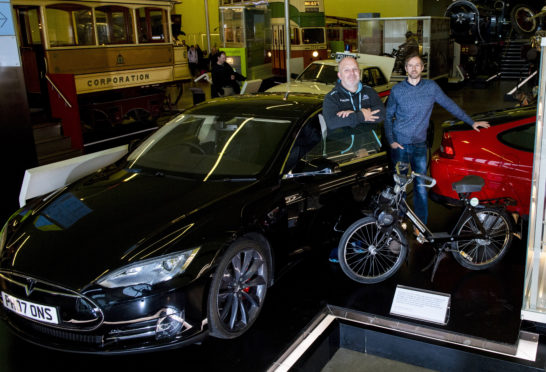
A Tesla electric car is among the exhibits at a new display in Glasgow’s Riverside Museum aims to highlight the legacy of one of Scotland’s most influential inventors.
Going Green – The Drive for Energy Efficiency considers James Watt’s pioneering spirit and his legacy in a modern-day context, where efforts to combat climate change are being raised.
Over 250 years ago the Greenock-born scientist invented a device called a ‘separate condenser’.
After years of experimentation, and persevering where others had failed, he successfully adapted existing technology and radically reduced the amount of coal required to drive a steam engine.
In doing so he not only greatly improved energy efficiency, but helped shape our modern industrial world.
New display! Going Green–The Drive for Energy Efficiency, sponsored by @Aggreko_ , considers James Watt’s pioneering spirit and his legacy in a modern-day context, where the desire to be increasingly energy efficient to combat climate change is ever-present. #GoGreen #sustainable pic.twitter.com/r9Z3DXvaQw
— Riverside Museum (@riversidemuseum) November 20, 2019
The display connects today’s global pressing need for renewable energies and inventions that reduce our reliance on finite fuels with James Watt’s inventions, which saved large amounts of fossil fuels.
The centrepiece is a Tesla Model S P85+, believed to be the first such vehicle acquired by a public museum in Scotland.
The pioneering car, gifted to the city by Chris Clarkson, represents a new dawn in electric vehicle development.
One section of the new display Driving Out Emissions considers how revolutionary changes in transport and the development of more environmentally friendly vehicles can reduce emissions and assist in tackling climate change.
Boasting a raft of innovative features and impressive technology, the Tesla Model S can travel 242 miles on one charge, at a cost of around £9.
It can reach 0-60mph in 4 seconds, be controlled from the owner’s smart phone and convert from a 5 to 7-seater family car.
Alongside the Tesla is a rare Honda Insight Mk1 from 2000. Donated by Charles Collins, it is one of only 239 Mk1s sold in the UK and was the first hybrid car to be acquired for the city’s renowned Transport and Travel collection.
Its inclusion in the display opens up a discussion on different power sources, from coal and quartz to wind and water and the ability to consume less of one by using more of another, as illustrated by the hybrid Honda which combines a conventional petrol engine with an electric motor.
Neil Johnson-Symington, Curator of Transport and Technology with Glasgow Museums said: ‘The inventor James Watt was full of ambition from the beginning. A determined, gifted engineer who changed our world forever, he has been honoured across the globe.
“As this new display shows his legacy lives on. It is also a wonderful demonstration of our commitment to contemporary collecting.”
Chris Clarkson who donated the Tesla and Charles Collins who donated the Honda visited the museum to unveil the new display, which is sponsored by Aggreko.
He said: “It’s wonderful to see the Tesla take its place in the new display, my family really enjoyed our time with this incredible machine and it’s exciting to see a car of the future now take up its place in history.
“My family and I love visiting the transport museum. They do a wonderful job of using interesting objects to tell important stories, such as the dangers of climate change and why we need to develop more environmentally friendly, fuel efficient vehicles.”
The new display will also feature a short film which relates to themes of energy efficiency and environmental monitoring as well as bringing to life the many diverse objects in Going Green – The Drive for Energy Efficiency.
Watt died in 1819 aged 83.
Since 1882 he has been honoured all over the world in the name of the SI unit of power.
In 2011 he was immortalised on the £50 note alongside his business partner Matthew Boulton – the first time two people have featured on the back of an English banknote.
Going Green – The Drive for Energy Efficiency is now open, located on the ground floor of the Riverside Museum

Enjoy the convenience of having The Sunday Post delivered as a digital ePaper straight to your smartphone, tablet or computer.
Subscribe for only £5.49 a month and enjoy all the benefits of the printed paper as a digital replica.
Subscribe